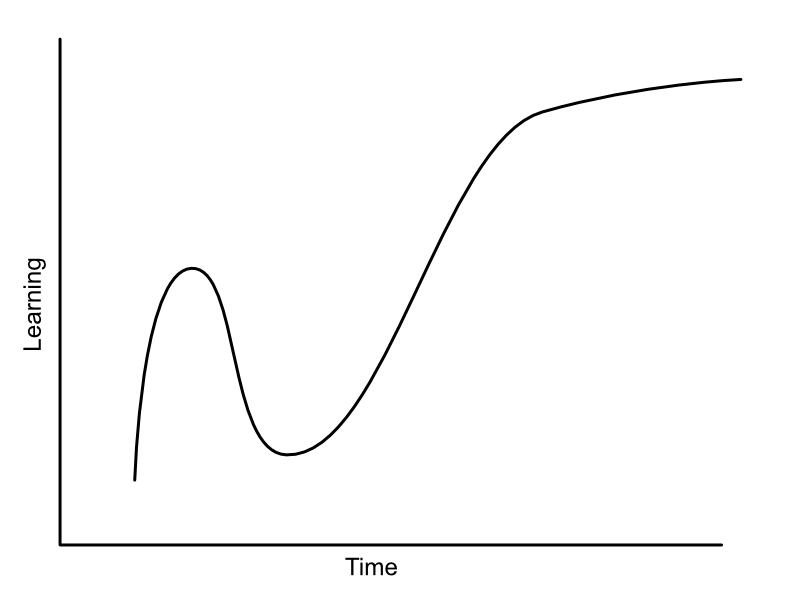For the last few years I have been thinking quite a bit about how we enable more people to learn programming. As an industry, we need more programmers universally and there seems to be a huge number of people who would want to come in. Unfortunately though we can’t seem to connect the 2 sides of this equation effectively.
Specifically I have been thinking about learning curves. Until recently I believed learning curves to follow a close-to-linear relationship with time. You learn a little bit at the beginning and are work on simple ideas and learn more and more as time goes by.

This seems to be codified in most programming books too, which introduce simple ideas at the beginning and then move towards more complex ideas
However, lately I feel a more honest representation of this learning curve we expect a newcomer to master would look something like this.

The initial hump in that graph represents a mountain of complexity that junior programmers are immediately handed before they can do anything with code. A lot of times this hump represents meta-work: things that are not core to the technology but elements like build systems or frameworks for testability, coding standards, etc
Take JavaScript for example. A “Hello world” JavaScript experience requires you to either start coding the way the industry strongly dislikes, the old fashioned way with script tags and vanilla JS, or learn the complexity of modules, package managers, build systems etc.
Same goes for mobile app development. For example if you are looking to make your first Android app, a brand new Android project using the Android Studio wizard drops you into a mess of Gradle, Java, Kotlin and XML files.
Tools like XCode and Android Studio also are extremely complicated for any beginner to use, with a ton of panels and tools to tap on without knowing what they do. Ironically, most of the teams building these tools have User Experience professionals on them and yet the ideas of progressive disclosure and first run experience, that as an industry we keep touting for our end user apps, are never considered.
Technology Complexity Cycle
Reflecting on my own learning-programming experience and talking about this with a few other people, I realize that another thing that got me into programming was also working on a technology (Flash) that wasn’t as mature.
When I started playing with Flash, it was back in the Flash-4 days with a very simple programming model where most of the code was written in small scripts attached to the timeline that just controlled the position of the animation playhead. My learning-to-code experience happened almost in-sync with the addition of complexity to Flash. Towards the last part of my experience with Flash, it had gotten complex enough with ActionScript3 and the need to become a “real” programming platform that it started to lose people.
I feel this happens a lot. Early versions of a programming platform are simple and functional and then, if it gathers attention of the “serious” programmers, way too much complexity gets added. This complexity makes the technology a daunting beast to new entrants.
The point is …
I had a couple of thoughts for new programmers that became the primary motivation for this post:
- Survive the initial hump: Getting started with learning programming is a lot harder in the beginning so stick with it. It does get easier as you cross the initial hump of tools and meta-work that goes into starting a project and very rarely revisited once the project is in active development
- Play with emerging technologies: Emerging technologies don’t often have a lot of initial hump as tooling and other meta-work hasn’t been invented yet. Technologies like WebVR, Blockchains, Flutter etc are great candidates to play with now and grow your skills as the technology matures.
And for those of us who have been in this industry for a while and may have the power to influence tooling and/or methodologies of how code is written, lets endeavor to make these more welcoming to folks with different levels of experience with tech.

One thought on “Learning Curves”